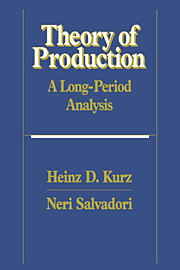Book contents
- Frontmatter
- Contents
- Preface
- A reader's guide
- 1 Free competition and long-period positions
- 2 A one-commodity model
- 3 Two-commodity models
- 4 Models with any number of commodities
- 5 Choice of technique
- 6 Alternative descriptions of a technique
- 7 Fixed capital
- 8 Joint production
- 9 Jointly utilized machines
- 10 Land
- 11 Persistent wage and profit rate differentials
- 12 On limits to the long-period method
- 13 Production as a circular flow and the concept of surplus
- 14 The neoclassical theory of distribution and the problem of capital
- 15 On some alternative theories of distribution
- Mathematical appendix
- References
- Name index
- Subject index
14 - The neoclassical theory of distribution and the problem of capital
Published online by Cambridge University Press: 06 January 2010
- Frontmatter
- Contents
- Preface
- A reader's guide
- 1 Free competition and long-period positions
- 2 A one-commodity model
- 3 Two-commodity models
- 4 Models with any number of commodities
- 5 Choice of technique
- 6 Alternative descriptions of a technique
- 7 Fixed capital
- 8 Joint production
- 9 Jointly utilized machines
- 10 Land
- 11 Persistent wage and profit rate differentials
- 12 On limits to the long-period method
- 13 Production as a circular flow and the concept of surplus
- 14 The neoclassical theory of distribution and the problem of capital
- 15 On some alternative theories of distribution
- Mathematical appendix
- References
- Name index
- Subject index
Summary
The analysis of production, distribution, and relative prices elaborated in this book derives from the contributions of Sraffa and von Neumann which, as has been argued in Chapter 13, can be strictly located in the “classical” tradition. The abandonment of the classical approach and the development of a different theory, which rose to dominance in the wake of the so-called marginalist revolution in the latter part of the 19th century, was motivated, among other things, by the deficiencies of the received labor theory of value. However, in terms of the method of analysis adopted the early neoclassical economists, including William Stanley Jevons (1871), Léon Walras (1874), Eugen von Böhm-Bawerk (1889), Knut Wicksell (1893, 1901), and John Bates Clark (1899), essentially followed the classical authors: the concept of “long-run equilibrium” is the neoclassical adaptation of the classical concept of long-period positions (see also Chapter 1).
This chapter is devoted to a brief discussion of major versions of the neoclassical theory of value and distribution. Attention will focus on those versions in which the long-period method of the classical economists is preserved; however, other, that is, more recent, versions will also be dealt with. In order to distinguish the former from the latter, which abandoned the long-period method and the concept of a uniform rate of profit, we shall henceforth call the earlier versions “traditional.” Browsing through contemporary literature one sees that traditional neoclassical theory is still used in many fields of economic theorizing.
- Type
- Chapter
- Information
- Theory of ProductionA Long-Period Analysis, pp. 427 - 467Publisher: Cambridge University PressPrint publication year: 1995



